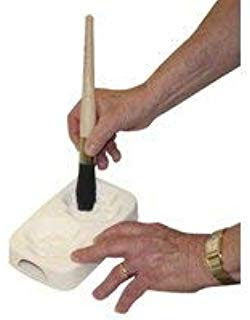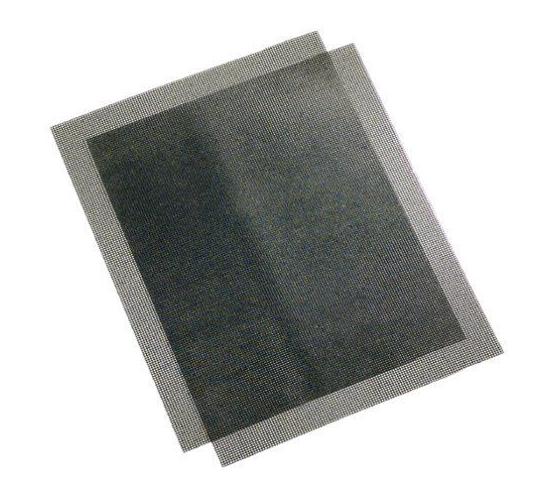Moulds
Kiln wash on ceramic moulds lasts a very long time. But
sometimes you want to use a different separator. First you need to prepare
yourself and the area for the process.
Preparation
It is best to wear a mask while
removing kiln wash or other separators to reduce the amount of dust you inhale.
Wearing an apron or other outer wear will keep the dust off your clothing.
Spread a cloth, newspaper or other
covering around the area. This is to be able to easily gather the removed kiln
wash and place it in the waste. Have a vacuum sweeper at hand to
remove powder rather than blowing it around the workspace. Of
course, if you can do this outside, there is much smaller risk of
contamination.
Removal Methods
The method of removing kiln wash depends in part on what the
mould material is.
Metal
You can sandblast,
manually sand, or wash off the kiln wash from metal moulds.
Ceramic
Sandblasting is not a safe method for ceramics, as it is so easy to damage the surface of the mould. Removing the kiln wash while dry is a good first approach. It saves having to wait long times for air drying and long kiln drying of the damp mould. You can lightly sand off the kiln wash from smooth surfaced moulds, and for detailed areas use rounded point wood and plastic tools. This can be backed up with a stiff nylon brush to clear out the narrow or detailed areas.
When these dry
methods are insufficient, there are wet approaches. I recommend dampening the
kiln wash rather than immersing the mould in water. The same tools can be used
as for the dry removal.
Soaking or washing the mould does not
remove the kiln wash as easily as you might think. It is especially
to be avoided where the mould has an internal hollow, as it may take days to
dry sufficiently to apply other separators. To put it in the kiln
risks breaking the mould by the steam build up during the initial rise in
temperature.
If you must soak the mould, I
recommend that you use a 5% solution of citric acid because it has a chelating
action on the kiln wash.
More information on removing kiln wash from moulds.
Remember that once the mould or shelf
has been coated with boron nitride, it is almost impossible to go back to kiln
wash again. The boron nitride irreversibly fills the porous element of
the ceramic, making it difficult for the kiln wash to adhere to the mould.
Shelves
The easiest surfaces to remove kiln wash from are flat or ones
nearly so.
Dry Methods
Abrasive methods work well with a variety of
tools. They can range from large paint scrapers to smaller ones with a
Stanley blade inserted.


Coarse open mesh plaster board (dry wall) sanding sheets are
very useful. There are frames that you can fix them to, but sanding without the
frame works well too.
Using power tools to sand the shelf is not advisable. It is too easy to remove lots of material, including the surface of the shelf – even the hard, ceramic ones. This leads to minor depressions in the shelf and consequent bubble difficulties when firing.
Do not be tempted to sandblast either, as that can easily
create the small depressions in the surface of the shelf that subsequently lead
to bubbles.
Wet methods
Wet methods can be used if you are concerned about the
dustiness of the process. You can dampen the kiln wash on the shelf and
sand or scrape as with the dry methods. You will create a paste or slurry
which can be bagged and put in the waste. You can also use the green scrubby
washing up pads. Unless you frequently rinse the pads, the kiln wash
builds up and clogs the pads. making them ineffective.
Some people use vinegar or chemicals such as lime away with
the water. The material that makes the kiln wash stick to the shelf is China
clay and the separator is alumina hydrate. Both of these elements are almost
impervious to the chemicals available to kiln workers. Instead, use citric
acid. It has a chelating action which will incorporate the particles of the
kiln wash. This will require some scrubbing, but avoids the smells of vinegar
and the risks of other chemicals.
Do not be tempted to use pressure washers. Yes, they will
remove the kiln wash. But it will also leave divots in the shelf which will
cause later problems with bubble creation.
A big drawback to using wet methods, is that the shelf
becomes wetted throughout and needs careful drying before use.
Both the wet and dry methods can be used on smooth, gentle
curved moulds. These include wave moulds, shallow moulds without flat bottoms,
cylinder moulds, and such like.
More information on Kiln Wash Removal from shelves is
available here,
and here.
Boron Nitride
A note on the reversibility of boron nitride. This is sold
under a variety of trade names such as Zyp, More, MR97, etc., and sometimes
under its chemical name.
Some people are applying boron nitride to ceramic moulds for
the "smoother" surface. Boron nitride is an excellent separator
for metal moulds and casting moulds whether metal or ceramic. But it has
limitations, including the price and the requirement for a new coating at each
firing. Some are beginning to wonder if they can go back to kiln wash
after having used the boron nitride.
The general experience has been that you can't apply kiln
wash on top of the boron nitride. It just beads up and flows off, because the
boron nitride creates a non-wetting surface that survives relatively high
temperatures. The kiln wash which is in water suspension has no opportunity to
adhere to the mould.
The most accepted way to get rid of the boron nitride is by
sandblasting. Sandblasting risks pitting the mould. Manual sanding seems to
enable the ceramic mould to accept kiln wash. Perhaps enough of the
surface is removed to reveal the porous nature of the ceramic mould. You do
need to be cautious about taking the surface of the mould away when using
abrasive removal methods. The ceramic is relatively soft in relation to the
abrasive materials.
The difficulty of removing boron nitride from ceramic moulds
means that you must think carefully about which moulds you coat with it.
If the mould has delicate or fine detail, removing the boron nitride
risks the removal of the detail. This indicates that this kind of mould,
once coated, should not be taken back to the bare mould.
If you are using boron nitride to get a smoother surface to
the object, consider using a lower slumping or draping temperature. This will
minimise mould marks very effectively. And without the expense of boron nitride.
More information on removal of boron nitride is given here.
More information about mould treatment is available in
the ebook: Low
Temperature Kiln Forming and at Bullseye ebooks






No comments:
Post a Comment